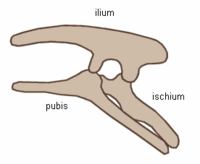Ornithischia
2007 Schools Wikipedia Selection. Related subjects: Dinosaurs
| iOrnithischia |
||||||||||
|---|---|---|---|---|---|---|---|---|---|---|
 Ornithischian pelvic structure (left side)
|
||||||||||
|
|
||||||||||
|
Extinct (fossil)
|
||||||||||
| Scientific classification | ||||||||||
|
||||||||||
|
|
||||||||||
|
Thyreophora |
Ornithischia or Predentata is an order of beaked, herbivorous dinosaurs. The name ornithischia is derived from the Greek ornitheos (ορνιθειος) meaning 'of a bird' and ischion (ισχιον) meaning 'hip joint'. They are known as the 'bird-hipped' dinosaurs because of their bird-like hip structure, even though birds actually descended from the 'lizard-hipped' dinosaurs (the saurischians). Being herbivores that sometimes lived in herds, they were more numerous than the saurischians. They were prey animals for the theropods and were smaller than the sauropods.
Characteristics
The Dinosauria superorder was divided into the two orders Ornithischia and Saurischia by Harry Seeley in 1887. This division, which has generally been accepted, is based on the evolution of the pelvis into a more bird-like structure (although birds did not descend from these dinosaurs), details in the vertebrae and armor and the possession of a 'predentary' bone. The predentary is an extra bone in the front of the lower jaw, which extends the dentary (the main lower jaw bone). The predentary coincides with the premaxilla in the upper jaw. Together they form a beak-like apparatus used to clip off plant material.
The ornithischian pubis bone points downward and toward the tail (backwards), parallel with the ischium, with a forward-pointing process to support the abdomen. This makes a four-pronged pelvic structure. In contrast to this, the saurischian pubis points downward and towards the head (forwards), as in ancestral lizard types. Ornithischians also had smaller holes in front of their eye sockets (antorbital fenestrae) than saurischians, and a wider, more stable pelvis. A bird-like pubis arrangement, parallel to the vertebral column, independently evolved three times in dinosaur evolution, namely in the ornithischians, the therizinosauroids and in bird-like dromaeosaurids.
Classification
The ornithischians are further divided in the two clades: the first are the Thyreophora and the second the Cerapoda. The Thyreophora include the Stegosauria (like the armored Stegosaurus) and the Ankylosauria (like Ankylosaurus). The Cerapoda include the Marginocephalia ( Ceratopsia like the frilled ceratopsidae and Pachycephalosauria) and the Ornithopoda (among which duck-bills (hadrosaurs) such as Edmontosaurus). The Cerapoda are a relatively recent grouping (Sereno, 1986), and may conceivably be identical to (synonymous with) the older group, Ornithopoda: most of these divisions are not true by definition.
Taxonomy
ORDER ORNITHISCHIA
- Pisanosaurus
- Family Fabrosauridae
- Suborder Thyreophora - (armored dinosaurs)
- Infraoder Stegosauria
- Infraorder Ankylosauria
- Cerapoda
- Suborder Ornithopoda
- Family Hypsilophodontidae
- Infraorder Iguanodontia
- Family Hadrosauridae - (duck-billed dinosaurs)
- Heterodontosauriformes
- Family Heterodontosauridae
- Suborder Marginocephalia
- Infraorder Pachycephalosauria
- Infraorder Ceratopsia - (horned dinosaurs)
- Suborder Ornithopoda
